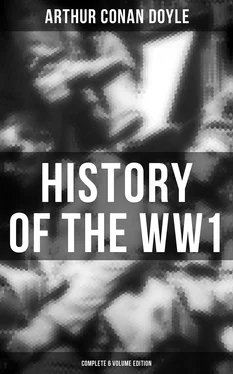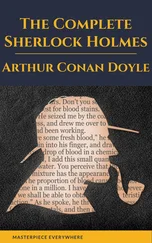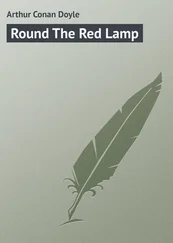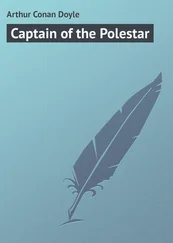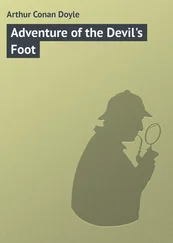Arthur Conan Doyle, Windlesham, Crowborough, April 1917.
I. The Opening Months of 1915
Table of Contents
Conflict of the 1st Brigade at Cuinchy, and of the 3rd Brigade at Givenchy —Heavy losses of the Guards—Michael O’Leary, V.C. — Relief of French Divisions by the Twenty-seventh and Twenty-eighth — British Pressure on the Fifth Corps—Force subdivided into two armies —Disaster to 16th Lancers—The dearth of munitions
The weather after the new year was atrocious, heavy CHAPTER rain, frost, and gales of wind succeeding each other L with hardly a break. The ground was so sodden that The . all movements of troops became impossible, and the months trench work was more difficult than ever. The British, with their steadily increasing numbers, were now able to take over some of the trenches of the French and to extend their general line. This trench work came particularly hard upon the men who were new to the work and often fresh from the tropics. A great number of the soldiers contracted frost-bite and other ailments. The trenches were very wet, and the discomfort was extreme. There had been some thousands of casualties in the Fifth Corps from this cause before it can be said to have been in action. On the other hand, the medical service, which was extraordinarily efficient, did everything possible to preserve the health of the men. Wooden troughs were provided as a stance for them in the trenches, and vats heated to warm them when they emerged. Considering that typhoid fever was common among the civilian residents the health of the troops remained remarkably good, thanks to the general adoption of inoculation, a practice denounced by a handful of fanatics at home, but of supreme importance at the front, where the lesson of old wars, that disease was more deadly than the bullet, ceased to hold good.
On January 25 the Germans again became aggressive. If their spy system is as good as is claimed, they must by this time have known that all talk of bluff in connection with the new British armies was mere self-deception, and that if ever they were to attempt anything with a hope of success, it must be speedily before the line had thickened. As usual there was a heavy bombardment, and then a determined infantry advance this time to the immediate south of the Bethune Canal, where there was a salient held by the 1st Infantry Brigade with the French upon their right. The line was thinly held at the time by a half- battalion 1st Scots Guards and a half-battalion 1st Coldstream, a thousand men in all. One trench of the Scots Guards was blown up by a mine and the German infantry rushed it, killing, wounding, or taking every man of the 130 defenders. Three officers were hit, and Major Morrison-Bell, a member of parliament, was taken after being buried in the debris of the explosion. The remainder of the front line, after severe losses both in casualties and in prisoners, fell back from the salient and established themselves with the rest of their respective battalions on a straight line of defence, one flank on the canal, the other on the main Bethune-La Bassée high road. A small redoubt or keep had been established here, which became the centre of the defence.
Whilst the advance of the enemy was arrested at this line, preparations were made for a strong counter-attack. An attempt had been made by the enemy with their heavy guns to knock down the lock gates of the canal and to flood the ground in the rear of the position. This, however, was unsuccessful, and the counter-attack dashed to the front. The advancing troops consisted of the 1st Black Watch, part of the 1st Camerons, and the 2nd Rifles from the reserve. The London Scottish supported the movement. The enemy had flooded past the keep, which remained as a British island in a German lake. They were driven back with difficulty, the Black Watch advancing through mud up to their knees and losing very heavily from a cross fire. Two companies were practically destroyed. Finally, by an advance of the Rifles and 2nd Sussex after dark the Germans were ousted from all positions in advance of the keep, and this line between the canal and the road was held once more by the British. The night fell, and after dark the 1st Brigade, having suffered severely, was withdrawn, and the 2nd Brigade remained in occupation with the French upon their right. This was the action of Cuinchy falling upon the 1st Brigade, supported by part of the 2nd.
Whilst this long-drawn fight of January 25 had been going on to the south of the canal, there had been a vigorous German advance to the north of it, over the old ground which centres on Givenchy. The German attack, which came on in six lines, fell principally upon the 1st Gloucesters, who held the front trench. Captain Richmond, who commanded the advanced posts, had observed at dawn that the German wire had been disturbed and was on the alert. Large numbers advanced, but were brought to a standstill about forty yards from the position. These were nearly all shot down. Some of the stormers broke through upon the left of the Gloucesters, and for a time the battalion had the enemy upon their flank and even in their rear, but they showed great steadiness and fine fire discipline. A charge was made presently upon the flank by the 2nd Welsh aided by a handful of the Black Watch under Lieutenant Green, who were there as a working party, but found more congenial work awaiting them. Lieutenant Bush of the Gloucesters with his machine-guns did particularly fine work. This attack was organised by Captain Kees, aided by Major MacNaughton, who was in the village as an artillery observer. The upshot was that the Germans on the flank were all killed, wounded, or taken. A remarkable individual exploit was performed by Lieutenant James and Corporal Thomas of the Welsh, who took a trench with 40 prisoners. A series of attacks to the north- east of the village were also repulsed, the South Wales Borderers doing some splendid work.
Thus the results of the day’s fighting was that on the north the British gained a minor success, beating off all attacks, while to the south the Germans could claim an advantage, having gained some ground. The losses on both sides were considerable, those of the British being principally among Scots Guards, Coldstream and Black Watch to the south, and Welsh to the north. The action was barren of practical results.
There were some days of quiet, and then upon January 29 the Fourteenth German Corps buzzed out once more along the classic canal. This time they made for the keep, which has already been mentioned, and endeavoured to storm it with the aid of axes and scaling ladders. Solid Sussex was inside the keep, however, and ladders and stormers were hurled to the ground, while bombs were thrown on to the heads of the attackers. The Northamptons to the south were driven out for an instant, but came back with a rush and drove off their assailants. The skirmish cost the British few casualties, but the enemy lost heavily, leaving two hundred of his dead behind him. “Having arranged a code signal we got the first shell from the 40th R.F.A. twelve seconds after asking for it.” So much for the co-operation between our guns and our infantry.
On February 1 the Guards who had suffered in the first fight at Cuinchy got back a little of what was owing to them. The action began by a small post of the 2nd Coldstream of the 4th Brigade being driven back. An endeavour was made to reinstate it in the early morning, but it was not successful. After daylight there was a proper artillery preparation, followed by an assault by a storming party of Coldstream and Irish Guards, led by Captain Leigh Bennett and Lieutenant Graham. The lost ground and a German trench beyond it were captured with 32 prisoners and 2 machine-guns. It was in this action that Michael O’Leary, the gallant Irish Guardsman, shot or bayoneted eight Germans and cleared a trench single-handed, one of the most remarkable individual feats of the War, for which a Victoria Cross was awarded. Again the fight fell upon the 4th Brigade, where Lord Cavan was gaining something of the reputation of his brother peer, Lord “Salamander” Cutts, in the days of Marlborough. On February 6 he again made a dashing attack with a party of the 3rd Coldstream and Irish, in which the Germans were driven out of the Brickfield position. The sappers under Major Fowkes rapidly made good the ground that the infantry had won, and it remained permanently with the British.
Читать дальше
